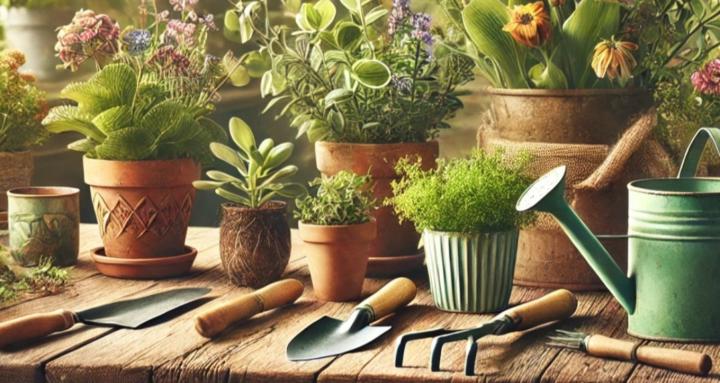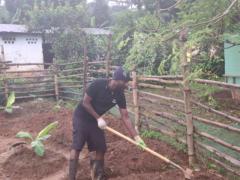Jul 9 • Pests & Plant Drama
Blossom End Rot: Why It Happens in Containers and How to Prevent It
You’ve been nurturing your container-grown tomatoes, peppers, or squash with care—only to discover a dark, sunken spot at the base of the fruit. That’s blossom end rot, and it’s a frustrating problem that strikes even the most attentive gardeners. The good news? It’s preventable with the right approach.
𝐖𝐡𝐚𝐭 𝐈𝐬 𝐁𝐥𝐨𝐬𝐬𝐨𝐦 𝐄𝐧𝐝 𝐑𝐨𝐭?
Blossom end rot is a physiological disorder (not a disease) caused by a calcium imbalance in the plant. It shows up as a black or brown leathery patch at the bottom (blossom end) of the fruit.
𝐖𝐡𝐲 𝐈𝐭 𝐇𝐚𝐩𝐩𝐞𝐧𝐬 𝐢𝐧 𝐂𝐨𝐧𝐭𝐚𝐢𝐧𝐞𝐫𝐬
* Inconsistent Watering: Fluctuations in soil moisture make it harder for plants to absorb calcium.
* Calcium Deficiency: Often not due to a lack of calcium in the soil, but the plant’s inability to take it up.
* Poor Soil Mix: Using soil that lacks nutrients or drains poorly can contribute.
* Overfertilizing: Excess nitrogen can promote rapid growth and outpace calcium availability.
𝐂𝐨𝐦𝐦𝐨𝐧 𝐂𝐫𝐨𝐩𝐬 𝐀𝐟𝐟𝐞𝐜𝐭𝐞𝐝
* Tomatoes (especially early fruit)
* Peppers
* Squash and zucchini
* Eggplant
𝐇𝐨𝐰 𝐭𝐨 𝐏𝐫𝐞𝐯𝐞𝐧𝐭 𝐁𝐥𝐨𝐬𝐬𝐨𝐦 𝐄𝐧𝐝 𝐑𝐨𝐭 𝐢𝐧 𝐂𝐨𝐧𝐭𝐚𝐢𝐧𝐞𝐫𝐬
𝟏. 𝐖𝐚𝐭𝐞𝐫 𝐂𝐨𝐧𝐬𝐢𝐬𝐭𝐞𝐧𝐭𝐥𝐲
* Keep soil evenly moist—not too dry or soggy.
* Water deeply and regularly, especially during hot or windy weather.
* Consider self-watering containers or drip irrigation for steady moisture.
𝟐. 𝐔𝐬𝐞 𝐭𝐡𝐞 𝐑𝐢𝐠𝐡𝐭 𝐏𝐨𝐭𝐭𝐢𝐧𝐠 𝐌𝐢𝐱
* Choose a high-quality potting mix with good drainage and organic matter.
* Avoid using straight garden soil or reused mix that may be depleted.
𝟑. 𝐀𝐝𝐝 𝐂𝐚𝐥𝐜𝐢𝐮𝐦
* Mix in crushed eggshells, bone meal, or garden lime when planting.
* Use a balanced liquid fertilizer with calcium if needed.
* Foliar sprays can help, but root uptake is more effective long-term.
𝟒. 𝐀𝐯𝐨𝐢𝐝 𝐎𝐯𝐞𝐫𝐟𝐞𝐫𝐭𝐢𝐥𝐢𝐳𝐢𝐧𝐠
* Too much nitrogen encourages leafy growth at the expense of fruit health.
* Use a balanced or low-nitrogen fertilizer designed for fruiting plants.
𝟓. 𝐂𝐡𝐨𝐨𝐬𝐞 𝐭𝐡𝐞 𝐑𝐢𝐠𝐡𝐭 𝐂𝐨𝐧𝐭𝐚𝐢𝐧𝐞𝐫 𝐒𝐢𝐳𝐞
* larger pots help regulate moisture and reduce stress.
* For tomatoes and peppers, aim for containers at least 5 gallons in size.
𝐖𝐡𝐚𝐭 𝐭𝐨 𝐃𝐨 𝐈𝐟 𝐘𝐨𝐮 𝐒𝐞𝐞 𝐈t
* Remove affected fruits to allow the plant to focus on healthy ones.
* Correct watering habits and assess soil nutrition.
* Don’t panic—plants often recover and go on to produce good fruit.
Blossom end rot can be a bump in the road, but it’s rarely a garden-ender. With a few tweaks to your container setup and care routine, you’ll be back on track to harvesting beautiful, healthy fruits in no time!
5
7 comments

skool.com/gardening
🌱 Unlock your green thumb in the most supportive container gardening group online — exclusive tips, plant hacks, and growing wins await!
Powered by





